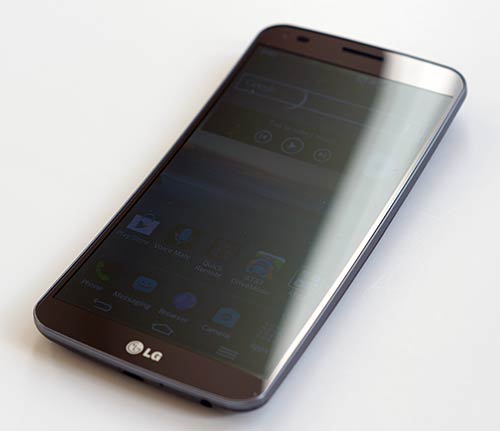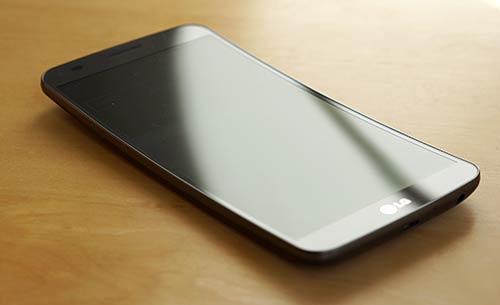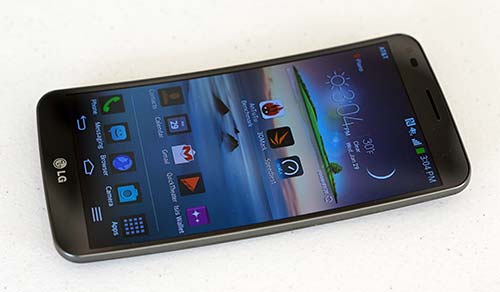Calling and Data
Before we get lost in the thrall of the first flexible, curvy phone and speak of megahertz and graphics chips, let's stop to consider the LG G Flex as a phone. It's available on several major carriers, and both signal strength and call quality will vary by carrier and their coverage strength in a given area. That said, we tested both the AT&T and Sprint models, and AT&T has very strong cover in our area (Dallas, TX), while Sprint's isn't as strong. In both cases, calls were clear with average volume, but not as clear as the LG G2, Samsung Galaxy Note 3 and iPhone 5s. Data speeds on AT&T and Sprint's network were typical and in line with other phones from those carriers: the AT&T model's LTE connection delivered very quick download speeds averaging 24Mbps according to the speedtest.net app, while Sprint averaged 7.6 Mbps. In as much as we can separate a phone from its network's strengths and weaknesses, the LG G Flex has average call quality and LTE 4G data speeds are as good as they get with current high end 4G phones.
Horsepower and Software
Nothing has changed here from the LG G2 and other Android phones running on the same 2.2GHz quad core Qualcomm Snapdragon 800 quad core CPU with 2 gigs of RAM. It's a fast phone and that's the fastest CPU you can get in an Android device. LG's UI, though not light, doesn't bog down the device and it feels responsive at all times. Thanks to the fast CPU and Adreno 330 graphics, combined with the relatively low pixel count, 3D games fly.
The LG G Flex has 32 gigs of storage with approximately 24.5 gigs available for your use. It does not have a microSD card slot, so you're limited to internal storage and the cloud or a USB flash drive if you buy a USB OTG adapter.
Sorry, no Android 4.4 KitKat here, at least not until LG issues a software update. The phone ships with Android 4.2.2 Jelly Bean and LG's custom UI, which bears similarity to Samsung's TouchWiz, right down to the 4-tabbed settings interface and split-window multitasking. Not that we mind the multi-tasking, which LG handles nicely, though the list of supported apps is shorter than Samsung's.
Benchmarks
Quadrant, AnTuTu, 3DMark & Sunspider Comparison:
| |
Quadrant |
3DMark |
AnTuTu |
Sunspider JavaScript Test (lower is better) |
| LG G Flex |
22,323 |
16,658 (unlimited) |
36,309 |
831 |
| LG G2 |
19,762 |
9803 (extreme) |
32,990 |
823 |
| Nexus 5 |
8808 |
17,828 (unlimited) |
27,017 |
718 |
| Sony Xperia Z1S |
21589 |
16,135 (unlimited) |
35,008 |
837 |
| Moto G |
8485 |
2778 (extreme) |
17,396 |
1311 |
| Samsung Galaxy Note 3 |
22,006 |
15,092 (unlimited) |
35,823 |
587 |
| Samsung Galaxy S4 |
12,276 |
11,601 (unlimited) |
24,776 |
826 |
| HTC One |
12,252 |
11,324 (extreme) |
24,589 |
1155 |
| Sony Xperia Z |
7916 |
6353 (extreme) |
20,403 |
1306 |
| Moto X |
8357 |
6800 (extreme) |
21,377 |
1097 |
| LG Optimus G Pro |
11,994 |
N/A |
18,561 |
867 |
| Samsung Galaxy Note II |
6001 |
N/A |
14,056 |
1052 |
| Samsung Galaxy S III |
5102 |
N/A |
7011 |
1825 |
Cameras
This is the same camera used in the LG G2, and we found a lot to like then and now. It's a 13 megapixel camera with LED flash, HDR and a variety of shooting modes like VR panorama, beauty shot, Intelligent Auto (a feature found on Sony cameras since this is a Sony module), burst shot and time catch (several frames captured over time to show a figure or object as it moves across the screen). Some have complained about the G Flex camera, but I found that like the G2, it captures sharp photos with plenty of detail. Colors are lifelike and natural and exposure is pretty good. The camera can shoot 1080p, 30 fps and 60 fps video, and it can shoot 4K UHD 3840 x 2160 video. It's a bit ahead of its time since few folks have 4K displays, but it's a great marketing point even if the video isn't mind-bogglingly pin sharp (hey, it's a camera phone).
A front 2.1MP camera handles video chat on Skype and other services nicely. Given the fairly high resolution, video isn't as blocky or noisy as on competing phones with lower megapixel ratings.
AV Remote
What's an Android phone without an IR blaster and AV remote app? The LG has QuickRemote, and it can control your TV, cable box, AV receiver, DVD player, Blu-ray player, projector and air conditioner. This is a pure remote control minus the TV grid found on the HTC One and various Samsung Galaxy phones and tablets. Unlike the LG G Pad 8.3 tablet that has a very pared down remote, this one controls all kinds of gear and many, many brands and models are supported.
Battery Life
Big phones need big batteries, and the LG G Flex has an ample 3500 mAh Lithium Ion polymer battery that's sealed inside (yes, it's curved too). Given the power efficiency of the Snapdragon 800 and the relatively low resolution display, battery life on the G Flex is very good. With moderate use, we managed two days on a charge with brightness set to 50% and LTE turned on (we tested both AT&T and Sprint models).
Conclusion
New designs are polarizing, but I suspect curved phones may be the future in a way that 3D phones were not. It's more comfortable to hold in the hand and against your face and it mitigates the hugeness of phablets a bit. The LG G Flex has top specs and it's fast, but I'm afraid the 720p display and higher price tag will turn off some folks. Honestly, the display is by no means bad so I suggest you take a look for yourself first.
Price $299 with contract, $675 full retail (retail price varies by carrier)
Websites: www.lg.com, wireless.att.com, www.sprint.com, www.t-mobile.com
Related Reviews:
LG G Flex 2 Review (new model that replaces the Flex)
LG G3 Review
Samsung Galaxy S5 Review
HTC One M8 Review
iPhone 6 Review
iPhone 6 Plus Review |




|

